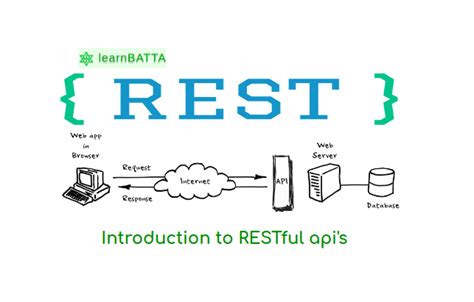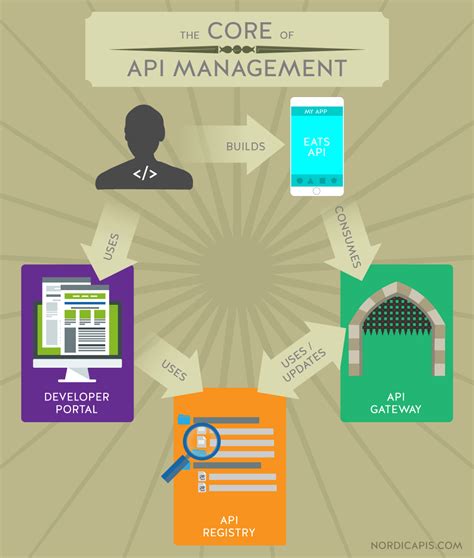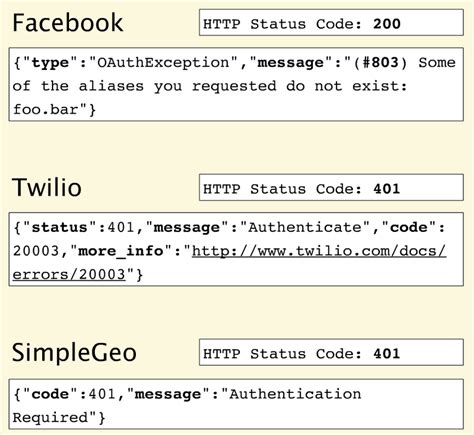Are you ready to elevate your iOS app development skills and take your creations to the next level? Look no further, as we delve into the world of Restful APIs and discover how they can revolutionize the way you build, communicate, and interact with your iOS applications.
By now, you may have already grasped the importance of integrating APIs into your mobile applications, but what exactly are Restful APIs? In essence, they are a set of rules and protocols that allow for seamless communication between different software applications. Just like a conductor orchestrating a symphony, Restful APIs enable your iOS app to effortlessly interact with external systems, services, and databases.
In this comprehensive exploration, we will guide you through the fundamental concepts of Restful APIs and demonstrate how they can enrich the functionality of your iOS apps. Whether you are a seasoned developer looking to expand your skill set or a beginner eager to dive into the intriguing world of API integration, this guide is tailored to address all levels of expertise.
Throughout this journey, we will unveil the secrets behind building robust and extensible iOS apps that can effortlessly tap into the vast resources available on the web. From authentication and data retrieval to pushing notifications and handling errors, we will equip you with the knowledge and tools necessary to navigate the intricate world of Restful APIs, ensuring that you are well-prepared to create immersive and highly interactive user experiences.
Introduction to Restful APIs

In this section, we will delve into the fundamental concept of Restful APIs and explore their significance in iOS development. Restful APIs serve as bridges that enable seamless communication between different software applications, facilitating the exchange of data and functionality. These APIs follow the principles of Representational State Transfer (REST), ensuring a standardized approach for building web services that can be easily consumed by various clients.
Restful APIs provide a structured and organized approach to building web services, enabling developers to create scalable and interoperable applications. They utilize HTTP methods like GET, POST, PUT, and DELETE to establish a consistent framework for accessing and manipulating resources on servers.
The key features of Restful APIs include statelessness, which means that each request contains all the necessary information to be processed without any reliance on previous interactions. These APIs also make use of uniform resource identifiers (URIs) to identify resources and leverage hypermedia as the engine of application state (HATEOAS) for navigating between different states of an application.
Restful APIs have gained immense popularity due to their simplicity, flexibility, and platform-independent nature. They allow developers to access resources over the web using lightweight and widely-supported formats such as JSON or XML. These APIs have become a cornerstone of modern software development, powering a wide range of applications including mobile apps, web services, and IoT applications.
In the next sections, we will explore the implementation of Restful APIs in iOS, discussing the best practices and tools available for building robust and efficient API-driven applications.
Advantages of leveraging Restful APIs in iOS app development
In today's rapidly evolving digital landscape, the incorporation of Restful APIs into iOS app development offers a multitude of benefits. This section explores the advantages of utilizing Restful APIs, enabling developers to enhance the functionality, user experience, and overall performance of their iOS applications.
1. Seamless Integration: Restful APIs provide a seamless way to integrate external services, databases, and functionalities into iOS applications. This enables developers to leverage the power of existing systems and third-party services, saving time and effort while expanding the capabilities of their apps.
2. Enhanced User Experience: By utilizing Restful APIs, developers can effortlessly retrieve and display dynamic content from the server in real-time. This enables the creation of interactive and engaging user interfaces, resulting in a more immersive experience for app users.
3. Efficient Data Management: Restful APIs facilitate efficient data management in iOS apps. By utilizing Restful API endpoints, developers can retrieve, update, and delete data from remote servers, enabling seamless synchronization of data between different devices and platforms.
4. Scalability and Flexibility: Restful APIs are designed with scalability in mind, allowing iOS apps to scale effortlessly as user demands and data volumes increase. Additionally, Restful APIs offer flexibility by providing a uniform interface that allows developers to easily modify or add new functionalities, ensuring the adaptability of iOS apps over time.
5. Security and Authentication: Restful APIs provide robust security features and authentication mechanisms, allowing developers to ensure the privacy and integrity of user data. By implementing secure protocols, such as OAuth or JWT, developers can protect sensitive information and authenticate users, enhancing the overall security of iOS applications.
6. Faster Development and Time-to-Market: Leveraging Restful APIs simplifies the development process by providing ready-to-use functionalities and services. This accelerates the development cycle, reduces development time, and improves the time-to-market for iOS apps, enabling businesses to stay ahead in the competitive app market.
By harnessing the advantages of Restful APIs, iOS developers can unlock a world of possibilities, allowing them to create highly functional, interactive, and secure applications that provide an exceptional user experience. The utilization of Restful APIs in iOS app development is crucial in meeting the evolving demands of a technology-driven world.
Exploring the Core Principles Behind Efficient API Communication

In this section, we will delve into a fundamental understanding of the principles that underpin the effective utilization of web-based APIs for seamless data exchange and integration in iOS applications. By grasping these core principles, developers can optimize the design and functionality of Restful APIs for enhanced user experience and improved performance.
Firstly, we will explore the concept of statelessness, which lies at the heart of Restful APIs. By emphasizing the absence of server-side session state, statelessness ensures that each client request contains all the necessary information for the server to process it, thereby simplifying the overall architecture and enhancing scalability.
Next, we will delve into the importance of a uniform interface. Keeping the design of the API consistent, regardless of the specific endpoints or resources being accessed, helps to ensure interoperability and ease of use. This principle promotes simplicity, allowing developers to create efficient and intuitive iOS applications that leverage the power of Restful APIs.
Another core principle we will explore is the concept of resource-oriented architecture. By modeling APIs around resources, such as users, messages, or data entities, developers can take full advantage of REST's capability to handle different operations (e.g., create, read, update, delete) on these resources through well-defined and standardized HTTP methods.
Additionally, we will delve into the significance of hypermedia as the engine of application state (HATEOAS). This principle encourages the inclusion of hyperlinks within API responses, enabling clients to navigate and interact with different resources dynamically. By leveraging HATEOAS, developers can create highly interactive and adaptable applications that fetch and utilize data efficiently through Restful APIs.
Lastly, we will touch upon the importance of proper error handling and status codes. Understanding how to leverage appropriate status codes, such as 200 for successful requests or 404 for resource not found, allows developers to provide clear and meaningful feedback to users, enhancing the overall user experience of the iOS application.
| Key Principles | Summary |
|---|---|
| Statelessness | Client requests contain all necessary information for processing, simplifying architecture and enhancing scalability. |
| Uniform Interface | A consistent design promotes simplicity, interoperability, and intuitive usage. |
| Resource-oriented Architecture | Modeling APIs around resources enables efficient handling of various operations through standardized HTTP methods. |
| HATEOAS | Including hyperlinks within API responses promotes dynamic resource navigation and interaction. |
| Error Handling and Status Codes | Appropriate status codes allow clear communication of success or failure to users. |
Choosing the Perfect Restful API for Your iOS Project
When embarking on an iOS project, one of the crucial decisions developers need to make is selecting the ideal Restful API to integrate. The choice of API can significantly impact the app's performance, user experience, and overall success. This section aims to guide developers through the process of evaluating and selecting the most suitable Restful API for their iOS project.
Understanding your Project Requirements
Before diving into the vast array of Restful APIs available, it is essential to have a clear understanding of your project requirements. Take a comprehensive look at the features your app will offer, the data it will handle, and the overall purpose it serves. This will enable you to identify specific functionalities and data endpoints that your Restful API needs to support.
Researching Available Restful APIs
Once you have a clear grasp of your project requirements, it is time to research the various Restful APIs available in the market. Look for APIs that are well-documented, actively maintained, and have a reliable track record. Consider the API's performance, scalability, security measures, and compatibility with iOS devices. Pay attention to the community support and developer resources available for each API, as these can be invaluable for troubleshooting and integration.
Evaluating API Documentation
Thoroughly evaluate the documentation provided by each Restful API you are considering. Look for clear and concise explanations of the API's functionalities, endpoints, and supported data formats. Well-documented APIs also provide detailed examples and code snippets that showcase the best practices and usage patterns.
Testing the API
Before finalizing your choice, it is recommended to test the Restful API you are considering. Set up a test environment to simulate real-world scenarios and check how the API handles various types of data and request/response formats. Pay attention to response times, error handling mechanisms, and the overall stability and reliability of the API.
Making the Final Decision
Once you have completed your research, evaluation, and testing, it is time to make the final decision on which Restful API to integrate into your iOS project. Consider the overall fit with your project requirements, the API's track record, community support, and developer resources. Remember that the chosen Restful API should not only meet your current needs but also have the potential to scale and adapt as your app grows and evolves over time.
By following the aforementioned steps, developers can ensure that they choose the perfect Restful API for their iOS project, laying a solid foundation for a successful and performant app.
Implementing Restful API calls in iOS using URLSession

This section explores the practical implementation of making Restful API calls in iOS applications using URLSession. URLSession is a native framework provided by Apple that allows developers to send HTTP requests and handle the corresponding responses.
In order to integrate Restful API functionality into an iOS app, developers can leverage URLSession to establish a connection to the API endpoint and interact with it using various methods such as GET, POST, PUT, and DELETE. URLSession provides a flexible and efficient way to handle network requests and manage data transfer between the application and the API.
The process of implementing Restful API calls using URLSession involves several steps, starting with creating a URLSession object and configuring its properties, such as setting the timeout interval and choosing an appropriate cache policy. Once the URLSession is configured, developers can utilize its methods to create and send API requests, including adding request headers, specifying the request method, and attaching any required parameters or payloads.
Upon sending a request, URLSession provides several methods for handling the response, such as receiving the response headers, reading the response data, and handling potential errors or failures. Developers can also implement delegates and callback methods to handle background downloads, track upload or download progress, and perform additional tasks after receiving the API response.
It is essential to handle the various scenarios that can occur when making API calls, including network connectivity issues, HTTP errors, and timeouts. Proper error handling and graceful error recovery mechanisms should be implemented to ensure a smooth user experience. Additionally, developers should consider implementing authentication mechanisms, such as handling token-based authentication or adding authorization headers to API requests, to secure the API integration.
Overall, implementing Restful API calls in iOS using URLSession provides developers with a powerful toolset to seamlessly integrate remote data retrieval and interaction into their iOS applications. With URLSession's comprehensive features and flexibility, iOS developers can easily create robust and efficient apps that seamlessly communicate with Restful APIs.
Securing Your iOS App: Managing User Access with Restful APIs
Incorporating authentication and authorization into your iOS app is vital for ensuring the security of user data and preventing unauthorized access. This section will delve into the various methods and best practices for handling user authentication and authorization when working with Restful APIs in iOS development.
1. Implementing User Registration: Before users can access your app and its features, they will need to create an account. This section will cover the steps required to securely handle user registration, including validating input, storing user credentials, and implementing password encryption.
2. Authentication using Tokens: Once users have registered, they will need to authenticate themselves when accessing your app. This part will explore the use of tokens as a secure method for user authentication. It will discuss the process of generating, storing, and validating tokens, as well as handling token expiration and refreshing.
3. Authorization and Access Control: While authentication verifies the identity of users, authorization determines their level of access to different resources within your app. This segment will explore how to implement role-based or permission-based access control to ensure that users can only access the appropriate features and data.
4. Securely Storing User Credentials: As an app developer, it is crucial to handle user credentials securely to protect against data breaches. This section will discuss best practices for storing passwords and other user credentials, such as using secure hashing algorithms and implementing additional layers of encryption.
5. Implementing Two-Factor Authentication: To provide an extra layer of security, you may choose to implement two-factor authentication (2FA) in your app. This section will cover the integration of 2FA methods such as SMS verification, email confirmation, or biometric authentication.
By implementing these strategies for handling authentication and authorization, you can enhance the security of your iOS app, protect user data, and build trust with your users.
Mastering Error Handling for Seamless Integration of Restful APIs

In the world of integration with Restful APIs, error handling plays a crucial role in ensuring the smooth functioning of an application. It's imperative to adopt best practices for handling errors effectively, providing a seamless user experience, and facilitating efficient debugging and troubleshooting processes.
Table of Contents
1. Understanding Error Types
Prioritize understanding the different types of errors that can occur during Restful API integration. Recognizing errors related to authentication, data validation, server errors, or network connectivity issues helps in devising appropriate error handling strategies.
2. Consistent Error Response Format
Establishing a consistent error response format ensures that error messages returned by the API are uniform and can be easily parsed and understood by the client application. Consistency simplifies error handling implementation and promotes better debugging and troubleshooting processes.
3. Appropriate HTTP Status Codes
Choose HTTP status codes wisely while handling errors. Utilize standard status codes such as 400 for client-side errors and 500 for server-side errors. Consistency in status codes allows developers to quickly identify and respond to different types of errors in a reliable manner.
4. Detailed Error Messages
Provide descriptive error messages that convey meaningful information to users and developers. Including relevant details like error codes, error descriptions, and possible resolutions facilitates troubleshooting and reduces the time required to resolve issues.
5. Robust Error Handling Implementation
Create a robust error handling implementation that gracefully handles errors without disrupting the user experience. Properly handle exceptions, timeouts, and other error scenarios to prevent crashes and unexpected behavior. Implement mechanisms for retries, caching, and fallback strategies where applicable.
6. Logging and Monitoring Errors
Implement logging and monitoring systems to track errors occurring during Restful API integration. Monitor logs and use appropriate tools to analyze error trends, identify patterns, and proactively address recurring issues. This proactive approach enhances the stability of the application and aids in continuous improvement.
7. Leveraging Retry Mechanisms
Integrate retry mechanisms to handle transient errors caused by temporary network issues or server unavailability. Implement exponential backoff techniques to avoid overwhelming the server with a large number of repeated requests. Leveraging retries mitigates the impact of intermittent connectivity issues and enhances the overall robustness of the integration.
By adhering to these best practices for error handling in Restful API integration, developers can ensure a reliable and seamless user experience, improve troubleshooting efficiency, and maintain the stability of their applications.
Optimizing performance and efficiency while utilizing Restful APIs in iOS
Enhancing the effectiveness and speed of your interactions with Restful APIs in iOS is crucial for creating a seamless and efficient user experience. By maximizing performance and streamlining operations, you can optimize your app's functionality and response times, ultimately leading to improved user satisfaction and retention.
One key aspect of optimizing performance is minimizing unnecessary network requests. By carefully managing the data flow between your app and the API, you can reduce the number of requests made, consequently minimizing network latency and conserving system resources. Implementing efficient caching mechanisms can also contribute to faster responses, especially when dealing with frequently accessed or static data.
Another strategy to enhance performance is the intelligent usage of parallel or asynchronous programming techniques. By adopting principles such as multithreading or dispatch queues, you can concurrently execute multiple network requests or data parsing operations, effectively utilizing available system resources and reducing overall processing time.
In addition, it is essential to ensure that your app properly handles error cases and timeouts encountered during API communications. By implementing robust error handling mechanisms and incorporating appropriate retry strategies, your app can gracefully recover from network failures or temporary disruptions, providing a more reliable user experience.
Efficiency can also be improved by optimizing data serialization and deserialization processes. Selecting the appropriate data interchange format, such as JSON or protocol buffers, can significantly impact performance. Additionally, employing efficient serialization libraries or custom parsing techniques tailored to your specific data requirements can further enhance processing speed.
| Optimization Techniques | Benefits |
|---|---|
| Minimizing network requests and implementing caching mechanisms | - Reduced network latency- Conservation of system resources |
| Utilizing parallel or asynchronous programming techniques | - Concurrent execution of requests- Efficient resource utilization |
| Implementing robust error handling and retry strategies | - Improved app reliability- Seamless user experience during network interruptions |
| Optimizing data serialization and deserialization processes | - Enhanced processing speed- Efficient data interchange |
By incorporating these optimization techniques into your iOS app's integration with Restful APIs, you can significantly elevate performance, maximize efficiency, and ultimately deliver a highly responsive and reliable user experience.
[MOVIES] [/MOVIES] [/MOVIES_ENABLED]FAQ
Why should I use Restful API in iOS development?
Restful API allows you to easily integrate your app with web services and retrieve data from a server. It provides a standardized way of communication between your app and the server, making it easier to fetch and send data. Using Restful API in iOS development can greatly improve the functionality and user experience of your app.
What are the advantages of using Restful API in iOS development?
Using Restful API in iOS development offers several benefits. Firstly, it allows you to separate the client and server code, making it easier to maintain and update your app. Secondly, it provides a flexible and scalable approach to data retrieval and manipulation. Restful API also enables you to access a wide range of web services and use their functionality within your app. Additionally, it fosters interoperability between different platforms and technologies, making it easier to integrate your app with other systems.
How can I implement Restful API in my iOS app?
Implementing Restful API in an iOS app involves several steps. Firstly, you need to identify the endpoints and data that you want to retrieve or send. Then, you can use frameworks like Alamofire or URLSession to send HTTP requests and handle the responses. You should also consider implementing authentication and error handling mechanisms to ensure secure and reliable communication with the server. Finally, you can parse the server response and update your app's UI accordingly. There are numerous tutorials and guides available online that provide detailed instructions on implementing Restful API in iOS development.




